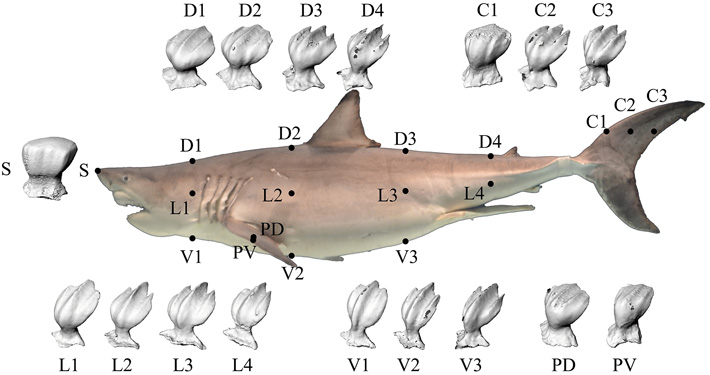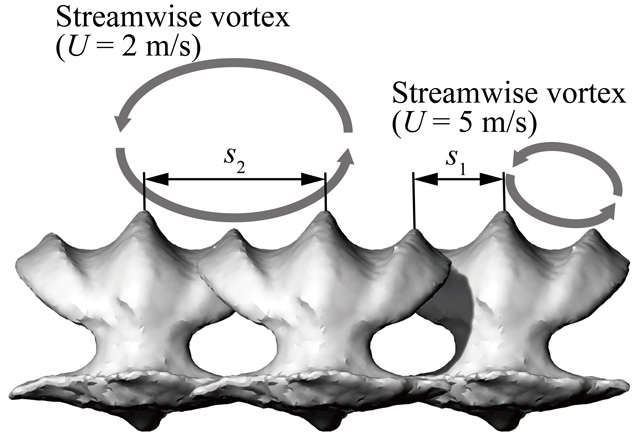New findings on how sharks achieve drag reduction could inspire the design of riblets for more efficient aircraft and boats. In their investigation of great white shark denticles, researchers from Tokyo Tech found that ridge height and spacing play crucial roles in drag reduction at different swimming speeds. Higher middle ridges aid sharks in efficient cruising at slower speeds, while the lower side ridges become more critical for drag reduction during high-speed hunting bursts. The analysis also suggests that the speeds of an extinct giant shark, megalodon, may not much differ from those of the white shark.

Figure 1. Skin Sampling Locations on a great white shark
Side view of a great white shark with highlighted skin sampling locations, showing detailed denticles captured by a microfocus X-ray CT scanner.
The great white shark, one of the ocean's most efficient predators, possesses tiny tooth-like structures on its skin called dermal denticles, which perhaps reduce frictional drag as it moves through the water. The drag reduction would help them to be swift hunters, reaching hunting speeds of up to 6.7 m/s, as well as long-distance swimmers, traveling distances of up to 20,000 kilometers efficiently. Engineers have drawn inspiration from these denticles to design riblets or small unidirectional ridges for aircraft and sailboats. However, the denticles across a shark's body vary in shape, size, and spacing, complicating the understanding of how they collectively affect drag reduction.
In a study published in the Journal of the Royal Society Interface, researchers from Tokyo Institute of Technology developed 3D models of white shark denticles. They analyzed the hydrodynamic size of high middle ridges and low side ridges of the denticles in relation to the shark's swimming speeds. The researchers found that these denticles are designed to reduce drag at a wide range of speeds, allowing sharks to gain bursts of speed for hunting and to cruise efficiently over long distances.
"Our calculations suggest that the combination of high and low ridges of the denticles results from adapting to both slow and high swimming speeds, thereby offering robustness to various swimming conditions," says Associate Professor Hiroto Tanaka, the corresponding author of the study.
The researchers collected skin samples from 17 different locations on a white shark (Carcharodon carcharias) specimen, including the snout, dorsal fin, lateral body, ventral body, caudal fin, and both the dorsal and ventral sides of the pectoral fin (Figure 1).
These samples were scanned with a microfocus X-ray CT scanner to create detailed 3D models, which were then analyzed to measure the spacing and height of the ridges. According to the previous fluid dynamic studies of riblets, the ridges of denticles possibly reduce friction drag by lifting turbulent vortices away from the surface of the shark's skin. These vortices are larger and farther from the skin at slower cruising speeds but shrink as the shark swims faster (Figure 2). Therefore, the spacing and height of these ridges are crucial because they determine how effectively the shark interacts with these vortices.

Figure 2. Shark denticles
Denticles with varying heights and spacing reduce drag by interacting with streamwise vortices. High middle ridges push away larger vortices at low cruising speeds (2 m/s), while smaller neighboring ridges handle smaller vortices at hunting speeds (5 m/s).
To study these aspects, researchers modeled the shark's body as a flat plate of the same length and defined non-dimensional values for the spacing (s+) of the denticle ridges. These values normalize the physical dimensions of the ridges by the flow characteristics. Non-dimensional parameters were calculated for swimming speeds of 1 m/s, 2 m/s, 5 m/s, and 10 m/s, and compared to a well-studied scalloped riblet similar to shark denticles. The reference riblet is known to reduce friction drag the most at s+ of 17. By comparing this value, researchers could determine how the ridge spacing of shark denticles influences drag reduction across different speeds.
As a result, the researchers found that the s2+ of the higher middle ridges becomes approximately 17 at 2 m/s, which corresponds to the measured migration speed. At hunting speeds of 5 m/s, s1+ of the neighboring high and low ridges becomes approximately 17 indicating the maximum drag reduction effect.
"High ridges likely reduce drag at low swimming speeds, and high-low alternating ridges reduce drag at high swimming speeds, covering the full range of swimming speeds. Our calculation method also can be applied to other sharks including extinct species," says Tanaka. Based on available data from fossils, the swim speeds of a megalodon, an extinct giant shark with similar denticle morphology, are calculated to be 2.7 m/s and 5.9 m/s, respectively. Thus, despite the large body, the megalodon's speed may not much differ from the white shark's. By uncovering how shark denticles work, this study could lead to new riblet designs with high and low ridges in engineering and new analysis methods for the biological study of shark evolution.
Reference
Authors : |
Shotaro Sayama1, Masahito Natsuhara2, Gento Shinohara3,4, Masateru Maeda5, Hiroto Tanaka1* |
Title : |
Three-dimensional shape of natural riblets in the white shark: relationship between
the denticle morphology and swimming speed of sharks |
Journal : |
Journal of the Royal Society Interface |
DOI : |
|
Affiliations : |
1School of Engineering, Tokyo Institute of Technology, Japan
2Shimadzu Corporation, Japan
3Department of Zoology, National Museum of Nature and Science, Japan
4The Hokkaido University Museum, Japan
5Faculty of Engineering, Takushoku University, Japan
|
* Corresponding author's email: tanaka.h.cb@m.titech.ac.jp
. Any information published on this site will be valid in relation to Science Tokyo.





